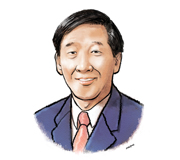
‘Taegeuk spirit’ for next president
 Few know the hidden meaning and symbolism in Korea’s national flag Taegeukgi.
Few know the hidden meaning and symbolism in Korea’s national flag Taegeukgi.
Is it a tennis ball? Does the red and blue in the center circle reflect the division of the Koreas? Does the red in the upper half of the circle mean the Communist North; the blue in the bottom half, the capitalist South Korea?
A foreigner scratches his head, puzzling whether four black trigrams in each corner of the flag convey the impression of the DMZ barbed wire or four superpowers surrounding the Korean Peninsula ― China, Russia, Japan and the United States. His casual description of the Taegeukgi is unsurprising and understandable. This is the image a casual foreigner has about the Taegeukgi.
Then how many Koreans know the hidden symbolisms of the flag?
In fact, Taegeuk, the “Great Ultimate,” contains a philosophical guiding principle for the country. The Taegeukgi has four colors ―white, red, blue and black.
The national flag’s white background reflects ancient Koreans’ penchant for the “color.” From ancient times, foreigners have called Koreans the “white-clad race.’’ White symbolizes cleanliness and a peace-loving people.
The red and blue Taegeuk in the center features the harmony of yin and yang through constant interaction. The red means the positive aspect yang, while the blue points to the negative aspect yin. Together, they represent a never-ending movement within infinity until the two merge into one.
The trigrams denote the four elements in the universe of heaven, fire, water and earth. They also feature the harmony of the four seasons ― spring, summer, fall and winter; nature ― the sky, sun, moon and earth; cardinal directions ― east, west, south and north; four virtues ― humanity, justice, intelligence and courtesy; the four pillars of the family ― father, mother, son and daughter. They also indicate justice, fruition, wisdom and vitality.
Despite Japan’s banning of any display of the flag, the Taegeukgi was a symbol of independence and resistance during its colonial rule.
King Kojong proclaimed the Taegeukgi as the official national flag in 1883 after Park Yeong-hyo purportedly designed it a year before.
A careful analysis of the Taegeukgi shows that the designer was under the strong influence of Chinese geomancy. Its core theme is the ultimate realization of greatness, harmony and unification through the constant interaction of opposing forces.
South Korea today is under never-ending clashes of opposing views and ideologies. Once people see these conflicts through the prism of the Taegeukgi’s spirit of harmony and unification, the social woes Korea faces are a temporary pain for full convergence.
In the presidential election, candidates of the conservative ruling and liberal opposition parties are to clash over their approach toward the Communist North. The governing party is hawkish toward the North while the opposition wants reconciliation. Their goal is not different. Namely the two camps want a peaceful coexistence of the divided Koreas and eventual unification.
An intense ideological debate has been brewing in society after alleged North Korea sympathizers Lee Seok-ki and Kim Jae-yon became lawmakers under the proportional representation system. Rep. Lee of the Unified Progressive Party has so far refrained from paying tribute to the Taegeukgi and singing the national anthem at official functions. Lee’s disparaging remarks against the Taegeukgi and Aegukga (national anthem) alienated even his party members and liberals.
Lee is under investigation for having become the lawmaker through rigging online voters. Despite mounting calls for his resignation, he has not moved an inch.
Some say the emergence of Lee and Kim as lawmakers is the byproduct of President Lee Myung-bak’s hawkish North Korea policy. They try to classify Lee, not as a pro-North Korea follower, but a radical advocate for a peaceful coexistence of the two Koreas. Even if he is a pro-North Korea follower, it would be better for him to be vocal and controversial in an institutionalized system, rather than plotting to topple the South through underground activities.
Conservatives and liberals are at odds over how to stimulate the economy. Conservatives tilt toward growth above welfare while liberals favor welfare above growth. Their objectives are the same, however. They strive for a strong economy that would make people happy and prosperous.
Public attention is now on who will be the successor to President Lee in an election six months from now.
At this stage, it is naive to predict who will win. Hopefully the next president will be an adherent to the Taegeuk spirit. He or she would be capable of harnessing the extreme views for a middle-of-road approach. The new leader would be neither one-sided nor dogmatic in inter-Korean relations. The leader will be able to either sympathize or empathize with the underprivileged socially, economically and institutionally. Nor will the leader antagonize the rich and chaebol.
The Taegeuk spirit values the differences as having a potentially synergistic effect for the country.
The Taegeukgi designer had emphasized the importance of yin-yang interactive communication for running the country harmoniously more than 120 years ago before the launch of Facebook or other social communication tools.
A successful candidate for the Great Power (daekwon in Korean) should be able to appreciate the spirit of the Great Ultimate (Taegeuk). An advocate of the Taegeuk spirit would be a successful president. The divisive and disoriented Korea badly needs the Taegeuk spirit of yin-yang harmony now. The Taegeuk should be a national logo. It also should be a presidential logo, replacing the emperor-like twin dragons roofing the national flower Rose of Sharon. <The Korea Times/Lee Chang-sup>


